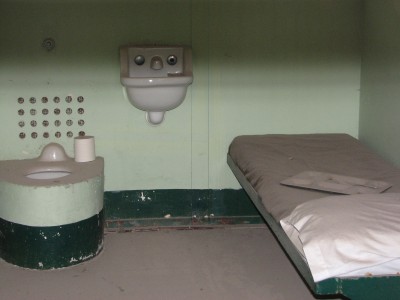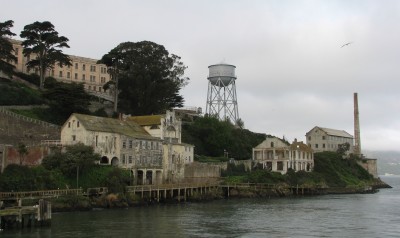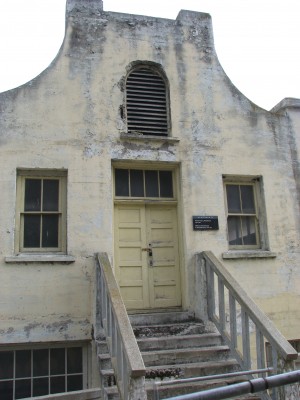In my last two posts, I described our morning at Alcatraz Island. Once we got back on the ferry to the mainland after our trip to Alcatraz, it wasn’t even noon yet. The day was still young! We walked over to Ghiradelli Square so I could get some chocolates for my co-workers, and we took a couple of photos there. To be honest, I’m not quite sure why Ghiradelli Square always tops the tourist lists of things to do. I had trouble finding chocolate there that I couldn’t find at the grocery store back home… Neither Jon nor I were feeling in the mood for a sundae, so that was a brief stop and then we were on our way again.
We hiked up the hill to our next destination – Lombard Street, aka “the Crookedest Street.” We were there four years ago, on our first-ever vacation as a couple. This section of the street has 8 switchbacks in one block, in order to make the 51% grade manageable for vehicles! I’m not sure who ever thought that would be a good idea! Apparently there is some dispute about whether it really is the crookedest street – it seems insane that some other city planner somewhere created something similar! It was fun to get pictures at the same place at the base of the street. Strangely, I was even wearing the same jacket!
After Lombard Street we walked over to Coit Tower – another place that we visited on our 2009 trip. Coit Tower was built to honor the memory of Lillie Hitchcock Coit, who was a wealthy socialite who lived from 1843 to 1929. She often pitched in to help firefighters of the day get their engines up the steep hills of the Telegraph Hill neighborhood, and was well known for wearing trousers and gambling when it was not appropriate for women to do so. When she died in 1929, she left about a third of her wealth (about $118,000) to the City of San Francisco, with instructions to use it for civic beautification. Coit Tower was the selected design from a contest that was held for ideas for a memorial on Telegraph Hill.
When you go inside Coit Tower, you find that the entire base is decorated with a series of murals, painted as a part of a New Deal employment project by the Public Works Administration during the Great Depression. The murals are amazing – very detailed and well done, and they provide a thought-provoking social commentary that is still relevant today. We spent quite a while going all around the base looking at the murals, but decided not to take the elevator up to the top of the tower on this trip.
After Coit Tower, we walked back to the hotel, through Chinatown, and rested our legs and feet for a little while. Then we navigated the bus system so Jon could make the trip over to the Haight-Ashbury district for a stop at his favorite record store – Amoeba. The bus driver was really patient with us as we fumbled around trying to figure out which bus to get on, and she even gave us free fares! It is nice to find people who are so helpful in big cities. And Jon loved his record store visit as well (as if you had any doubts!).
After our Haight-Ashbury excursion, we had intended to head to North Beach to find a nice little Italian restaurant that we had been to before. But there wasn’t a bus that would take us directly from Haight-Ashbury to North Beach, and we would end up in the vicinity of our hotel again and then have to transfer. As we had been walking all day, and had probably been at least 8 miles at that point, we decided to find something near our hotel. I had seen an Asian fusion restaurant around the corner from the hotel and we decided to check it out. We were not disappointed!
We walked into E&O Asian Kitchen about 7, and it was just getting busy. Even though we didn’t have a reservation, they were able to seat us right away at a small pub-style table near the bar. We checked out the wine list and made our selections. I ordered a French Rosé called Triennes, from Provence, which is made primarily from Cinsault with small amounts of Syrah, Grenache and Mourvedre blended in. It was very tart and citrusy, and I enjoyed it immensely. Jon ordered a 2010 Cristom Pinot Gris, an Oregon winemaker – his was good too, with more pear flavor, but I liked mine better.
For food, E&O does a lot of small plates, like tapas that are meant for sharing. We ordered the Satay Platter, which came with four different types of kebabs, and you got two of each. They were:
- Hangar Steak – marinated with ginger, garlic and soy
- Chicken – free-range chicken marinated with lemongrass, tumeric and peanut sauce
- Shrimp – marinated in Thai basil and mango
- Portobello mushroom – with a soy glaze
The dish came with pickled vegetables – carrots and cucumbers, which were a nice accompaniment to the rich meats and sauces. We also ordered the local asparagus, which was seasoned with sesame, ginger, miso and egg and grilled. And we had the wood roasted edamame with shiso fumi furikake and maldon salt. To be honest, I don’t even know what that means, but they were amazing edamame! This meal was one of the best of our trip!
If you think you might want to check it out, here’s their website: http://www.eosanfrancisco.com/. My only word of caution would be that the dress code is a bit dressy/stylish/yuppie (as might be expected in San Francisco). Jon was wearing a college hoodie sweatshirt and felt underdressed. But don’t worry, nobody looked at him funny or said anything either…
And with the glow from that amazing meal, we wrapped up another day in San Francisco. I took a bath in the clawfoot tub of the hotel to pamper my overused feet, and reflected on a fantastic day!
And you if you are interested in checking out what I wrote about our 2009 San Francisco trip, back when I first started this blog:












































